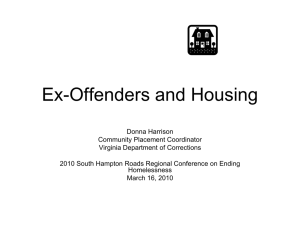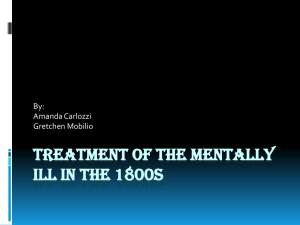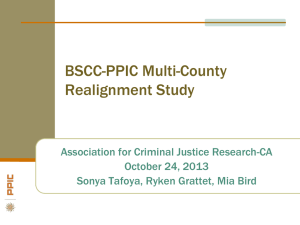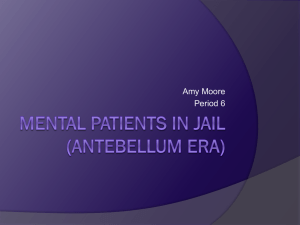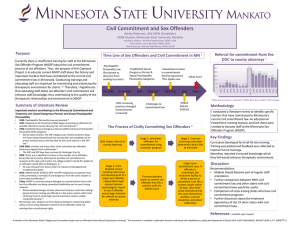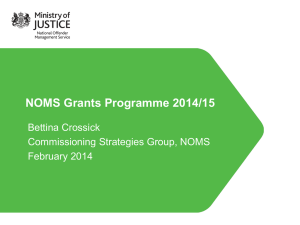Ray Roberts
advertisement
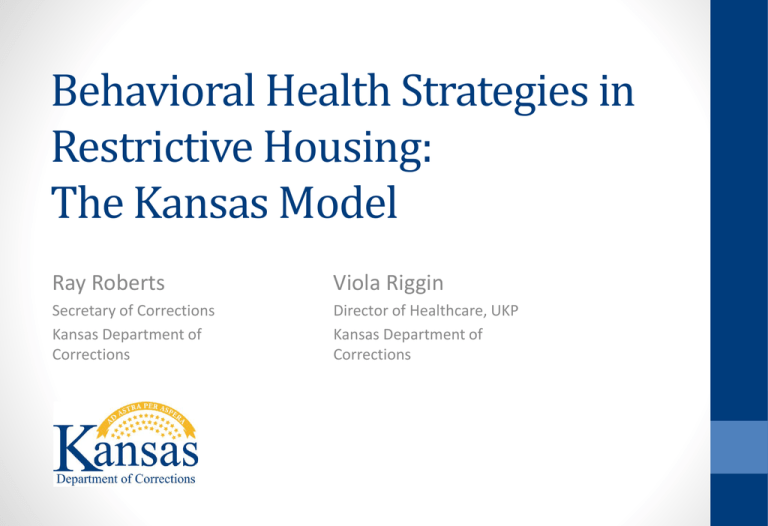
Behavioral Health Strategies in Restrictive Housing: The Kansas Model Ray Roberts Viola Riggin Secretary of Corrections Kansas Department of Corrections Director of Healthcare, UKP Kansas Department of Corrections Why review restrictive housing placements? • Bring the State into compliance with standards associated with the caring for mentally ill offenders in Restrictive Housing (RH). • Increase access to treatment for the mentally ill in RH. • Better understand the clients we serve in RH units. • Provide a safe environment in RH for staff and offenders. • Provide a safer plan for releasing mentally ill offenders from RH. 2 Background - KDOC Special Needs Offenders • The table shows the number of offenders requiring consistent mental health follow up due to serious mental illness. The graph indicates historical numbers from FY09 through FY14. • On average, the special mental health needs population increased 13.8% each year (year-to-year) between FY09 and FY14. Average Special Needs 1400 1281 1200 1000 1029 800 818 600 869 943 671 400 200 0 FY 9 FY 10 FY 11 FY 12 FY 13 FY 14 3 KDOC Statistics for Mentally Ill Mentally Ill Inmate Population As of September 4, 2014 | Of the 9,616 total KDOC inmate population: 1,057 (11%) Severely Persistently Mentally Ill (SPMI) Serious Mental Illness (SMI) 1,827 (19%) 673 (7%) Transient Mental Health Issues SMI Housed in RH Units SPMI Housed in RH Units 2011 2014 261 47 2011 2014 385 245 • In 2011: 646 mentally ill offenders, representing 7.0% of the population, were housed in RH Units. • In 2014: the number reduced more than half to 292 mentally ill offenders in RH Units. • Today, 3% of the total SMI population and 0.48% of the SPMI population are housed in RH Units. 4 Development Team Secretary of Corrections established a multi-disciplinary development team to investigate and improve the overall identification and treatment of the mentally ill housed in RH Units. Team members included: • Deputy Secretary of Facilities Management • Director of Healthcare Services • Mental Health Program Administrator • Wardens from five prisons with largest population of mentally ill in RH Units • Classification Staff • Deputy Warden for Programs 5 Development Team: Primary Goals • Buy-in from Wardens and classification staff • Standardize definition of “long-term restrictive housing” • Review and establish policies to affect long-term change in RH Units • Address safety issues by defining the role of members of the “Restrictive Housing Review Board’ to a multi-disciplinary team process • Develop facility space for treatment / programming activities • Identify alternative and creative means to provide treatment • Develop additional training for behavioral health professionals and operations staff • Establish outcome measures to track progress 6 Facility MH Classification Type of Program LCMHF MH Levels 4, 5 & 6 MH Level 3 in crisis RH with BH TX Program (Due Processed) Treatment Units EDCF MH Levels 3, 4, 5, & 6 RH with BH TX Program Treatment Unit TCF TU MH Levels 3, 4, 5, & 6 Treatment Unit TCF MH Levels 3, 4, 5, & 6 RH with BH Treatment LCF TRU-I MH Levels 3, 4, 5, & 6 Treatment Unit LCF MH Levels 3-4 RH with BH TX Program Treatment Unit HCF MH Levels 3-4 RH with BH TX Program Treatment Unit ECF & NCF MH Levels 3 – 4 RH with BH TX Program All Other RH Units MH Levels 1 – 2 RH with Access to BH TX no formal program Type of program by facility – LCMHF, TCF & EDCF are designated facilities for offenders requiring the highest level of treatment (level 5 & 6) 7 Example: RH Unit with Treatment Facility LCMHF will be the primary treatment facility for the highest acuity mentally ill offenders. LCMHF houses the following Mental Health Level 3 – 6 offenders: • 1 unit (30 beds) RH-BH Treatment • 3 units (90 beds) Treatment Units TCF-TU will be the primary treatment facility for the highest acuity mentally ill female offenders. • 1 unit (10 Bed) RH- Behavioral Health Treatment Unit • 1 unit (15 Bed) TU-Treatment Unit for Females Goals • Provide approximately 10 hours of BH treatment and 10 hours of KDOC activities weekly to offenders who have proven to be especially violent when placed less-structured environments. • Allow an avenue for offenders to move toward a less-structured BH unit as violent behavior lessens. 8 Phase I: Training Staff within RH units receive specialized training from an advanced curriculum. Those requiring specialized training include: • Facility Administration • Unit management staff • Security staff in special placement units • BHP • Nursing staff Specialized training should focus on: • Characteristics/risk factors associated with managing offenders in RH • Understanding mental illness • Recognizing symptoms of major mental disorders • Suicide/self-injury prevention • Detecting signs of deterioration • Crisis response • Indicators for referrals • Motivational aspects 9 Phase II: Measuring Progress Secondary review process • Central Office BH program staff reviews offenders placed in RH and treatment units to ensure offenders with SMI are recognized and provided treatment • Self-monitor through the quality assurance process by on-site clinical staff monthly – site level • Central Office BH program staff conducts at least quarterly monitoring for compliance with program requirements. • Submit monthly report • Identifying numbers of offenders in each program • Additional outcomes to the Deputy Secretary of Facilities Management • Review offenders with recurring patterns of RH placement of more than 6 times in a 12-month period and with a MH classification of 3-6. • Develop outcome measures for clinical and administrative management of mentally ill offenders in RH. 10 Obstacles During Program Development • Establishing a balance between safety and treatment options • Behavioral health clinical staff: • Lack clinical staff /funding for staff • Where to place treatment units that had adequate community support • Lack of space/space not adequate for treatment needs • Current staff training and skill sets did not meet needs identified • Lack of staff to mine data to identify the types of offenders and their needs • Operational Issues: • Training did not meet site staff needs • Correctional officer staffing levels and skill set had to increase • Safety concerns for dealing with erratic behavior • Cost – funding • Burnout for staff who work high-intensity units 11 Key Successes: What’s Changed • Early support from the Governor • Led to legislative support on budgeting for MH staff increases • Buy in by senior management • Development of a team approach • Train staff often and early • Participation of line staff to change and add ideas during the development phase provided great enhancement ideas • Developed a draft plan that forces the function to create individualized case management and treatment through a multi-disciplinary approach • Screened clients and mined the data to identify who needed services and where they were • Made the data important • Implementing follow up/monitoring tools to maintain the program long term 12 Resources Used in the Program • Dr. Lorelei Ammons, Psy.D. Kansas University Physician Inc. Kansas Department of Corrections. • American Correctional Association (2003). Standards for Adult Correctional Institutions 4th Edition. • American Correctional Association (2012). 2012 Standards Supplement. • American Correctional Association (2014). Town Hall Meeting on Offenders with Mental Illness In restrictive Housing. January, Tampa, FL. • American Correctional Association (2014). Plenary Session on Offenders with Mental Illness in Restrictive Housing. September, Salt Lake City, UT. • American Psychiatric Association (2012). Position Statement on Segregation of Prisoners with Mental Illness. • Aufderheide, D. (2013) Mental Illness in Administrative Segregation: 10 Key Components to Bulletproof Your Mental Health Program Against Litigation. • Brown, J. (2013). ACLU Uncovers Increased proportion of Mentally Ill Inmates in Solitary. The Denver Post.. • Dvoskin, Joel; Controversies Concerning Supermax Confinement and Serious Mental Illness; based on Metzner, JL & Dvoskin, JA. (2006) Controversies concerning Supermax Confinement and Mental Illness. Psychiatric Clinics of North America. Philadelphia: Elsevier. Volume 29, No.3. • Metzner JL, Dvoskin JA: An Overview of Correctional Psychiatry. Psychiatric Clinics N Am, 29: 761772, 2006. • Morgan DW, Edwards AC, Faulkner LR: The adaptation to prison by individuals with schizophrenia. Bulletin of the American Academy of Psychiatry and the Law, 21, 427-433, 1993. 13

